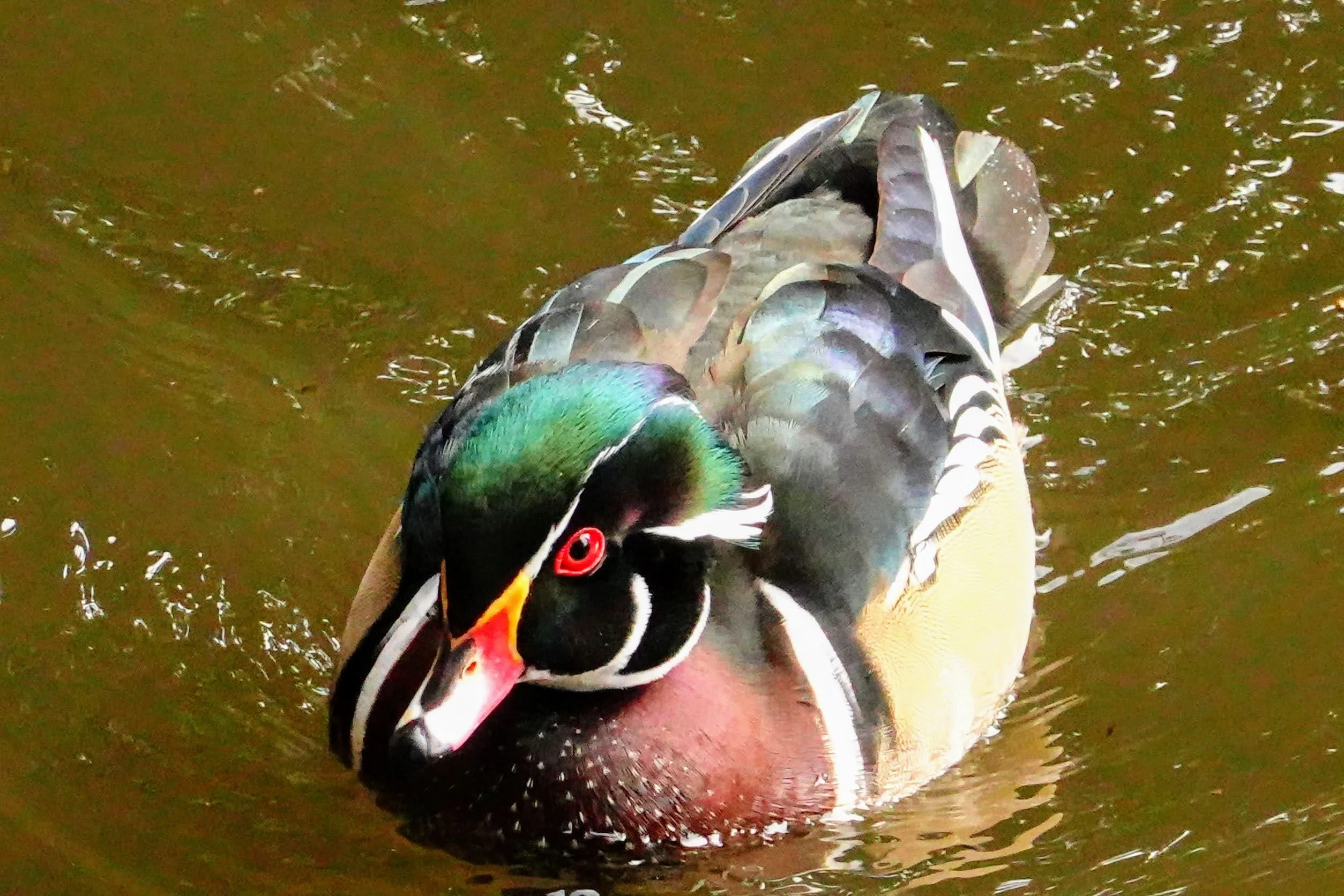The first time I saw Wood Duck was at the Los Angeles Arboretum in 2019. I was attracted by its conspicuous feathers. All About Birds described it as “The Wood Duck is one of the most stunningly pretty of all waterfowl.” This description is really not an exaggeration at all. On February 26, 2021, I saw it was at Peck Road Park. It slept among several common ducks, with its neck curled up. I almost missed it without paying attention to it. Fortunately I looked at it more closely and I quickly grabbed the camera to take a few pictures. I saw it again swimming in the lake on March 2, 2021. The wood duck is a medium-sized perching duck found in North America. It is one of the most colorful North American waterfowl. It shares its genus with the Asian Mandarin duck (Aix galericulata). The adult male has distinctive multicolored iridescent plumage and red eyes with a distinctive white flare down the neck.
我第一次看到林鴛鴦是在2019年在洛杉磯植物園,被它顯眼亮麗的羽毛吸引住了。All About Birds 如此形容它”林鴛鴦是所有水禽中最漂亮的一種 “,真的一點也不誇大其辭。2021.02.26在Peck Road Park,它混在數隻不起眼的鴨子中間睡覺,脖子縮起來,不留心差一點錯過它了,幸好我多看它兩眼,趕緊抓起相機照幾張。2021.03.02 再一次看到它逍遙自在的在湖中游泳。林鴛鴦(又名樹鴛鴦、美洲鴛鴦、美洲木鴨)是在北美的一種中型棲鴨,它是北美最鮮豔的水禽之一。它與亞洲鴛鴦(Aix galericulata)是同一屬。成年雄鴨有獨特的五彩繽紛的羽毛和紅色的眼睛,脖子下有獨特的白色條紋。














Wood duck’s beautiful plumage is unforgettable. On December 21, 2021 I saw a Wood duck at the LA Arboretum and started staring at it to take pictures. When we strolled to the other side of the lake, we saw a Wood duck again (I was not sure if it was the same one or not). This Wood duck was not shy at all. It swam around in front of me and walked past me without fear after climbing on the shore so that I could take a few more photos.
林鴛鴦漂亮的羽毛是令人難忘的。2021.12.21在洛杉磯植物園看到林鴛鴦就緊盯著它拍照。我們逛到湖的另一邊,居然又看到一隻不怕羞的林鴛鴦(不知道是不是同一隻),在我眼前游來游去,爬上岸也不怕的走過我身旁,讓我可以多拍幾張照片。






We haven’t seen Wood ducks at the Los Angeles Arboretum for quite a while. The water where we saw them last time in 2019 has dried up. This time we saw them in a different area in 2023, which was very pleasantly surprising.
有好一陣子沒在洛杉磯植物園看到林鴛鴦,最早2019年看到它們的地方水已經乾涸,這次2023年我們在不同的水池中看到它們,非常驚喜。



Notes 筆記
- The wood duck or Carolina duck is a medium-sized perching duck found in North America. It is one of the most colorful North American waterfowl.
- It shares its genus with the Asian Mandarin duck (Aix galericulata).
- The adult male has distinctive multicolored iridescent plumage and red eyes with a distinctive white flare down the neck. The female, less colorful, has a white eye-ring and a whitish throat. Both adults have crested heads.
- Their breeding habitat is wooded swamps, shallow lakes, marshes or ponds, and creeks in eastern North America, the west coast of the United States and western Mexico.
- Unlike most other ducks, the wood duck has sharp claws for perching in trees and can, in southern regions, produce two broods in a single season—the only North American duck that can do so.
- These birds feed by dabbling or walking on land. Dabbling means to search for food from the surface of the water, as opposed to diving underneath the surface to scavenge for food. They mainly eat berries, acorns, and seeds, but also insects, making them omnivores.
- The birds are year-round residents in parts of its southern range, but the northern populations migrate south for the winter. 75% of the wood ducks in the Pacific Flyway are non-migratory.
- The population of the wood duck was in serious decline in the late 19th century as a result of severe habitat loss and market hunting both for meat and plumage for the ladies’ hat market in Europe. In response to the Migratory Bird Treaty established in 1916 and enactment of the U.S. Migratory Bird Treaty Act of 1918, wood duck populations began to recover slowly. The population of the wood duck has increased a great deal in the last several years. The increase has been due to the work of many people constructing wood duck boxes and conserving vital habitat for the wood ducks to breed. It is the second most commonly hunted duck in North America, after the mallard.
- 林鴛鴦或卡羅來納州鴨是在北美的一種中型棲鴨。 它是北美最鮮豔的水禽之一。 (註: 又名樹鴛鴦、美洲鴛鴦、美洲木鴨,是鴛鴦屬的一種鳥類)。
- 它與亞洲鴛鴦(Aix galericulata)是同一屬。
- 成年雄鴨有獨特的五彩繽紛的羽毛和紅色的眼睛,脖子下有獨特的白色條紋。雌鴨較不鮮豔,有白色的眼圈和白色的喉嚨。雄雌都有獨特羽冠。
- 它們的繁殖棲息地是樹木繁茂的沼澤、淺湖、濕地或池塘,以及北美東部、美國西海岸和墨西哥西部的小河。
- 與大多數其他鴨不同,林鴛鴦具有尖銳的爪子可以棲息在樹上,並且在南部地區可以在一個季節內繁殖兩個雛鴨,這是北美唯一可以做到這一點的野鴨。
- 這種鴨是在陸地上或涉水來覓食。涉水是指從水面尋找食物,而不是在水面以下潛水尋找食物。它們主要吃漿果、橡子和種子,但也吃昆蟲,它們是雜食動物。
- 林鴛鴦在其南部範圍的部分地區是留鳥,但北部種群在冬季越冬時向南遷移。太平洋航線上的林鴛鴦中有75%是非遷徙的。
- 19世紀後期,由於棲息地嚴重喪失以及歐洲女士帽子市場為肉類和羽毛的獵殺,林鴛鴦的數量急劇減少。為響應1916年制定的《候鳥條約》和1918年《美國候鳥條約法》的頒布,林鴛鴦種群開始緩慢恢復。在最近幾年中,林鴛鴦的數量大量增加。增長的原因是許多人建造林鴛鴦箱並保護重要的棲息地,以供林鴛鴦繁殖。它是北美第二大獵殺鴨,僅次於綠頭鴨。
References 參考資料
Birds Posts 鳥的帖子
Comments